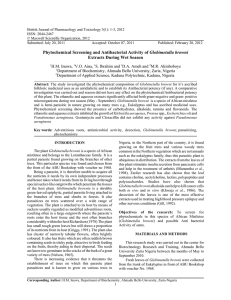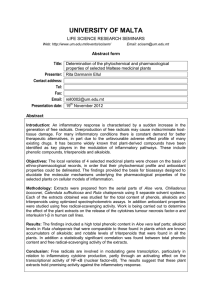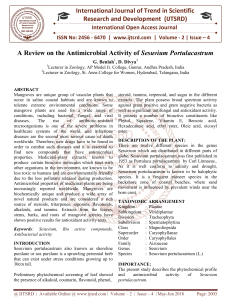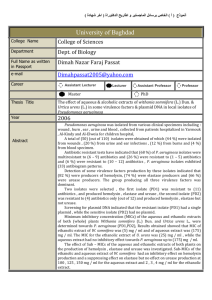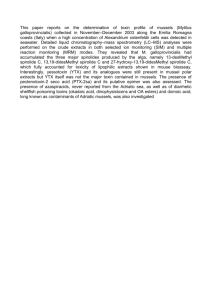British Journal of Pharmacology and Toxicology 3(1): 4-6, 2012 ISSN: 2044-2467
advertisement
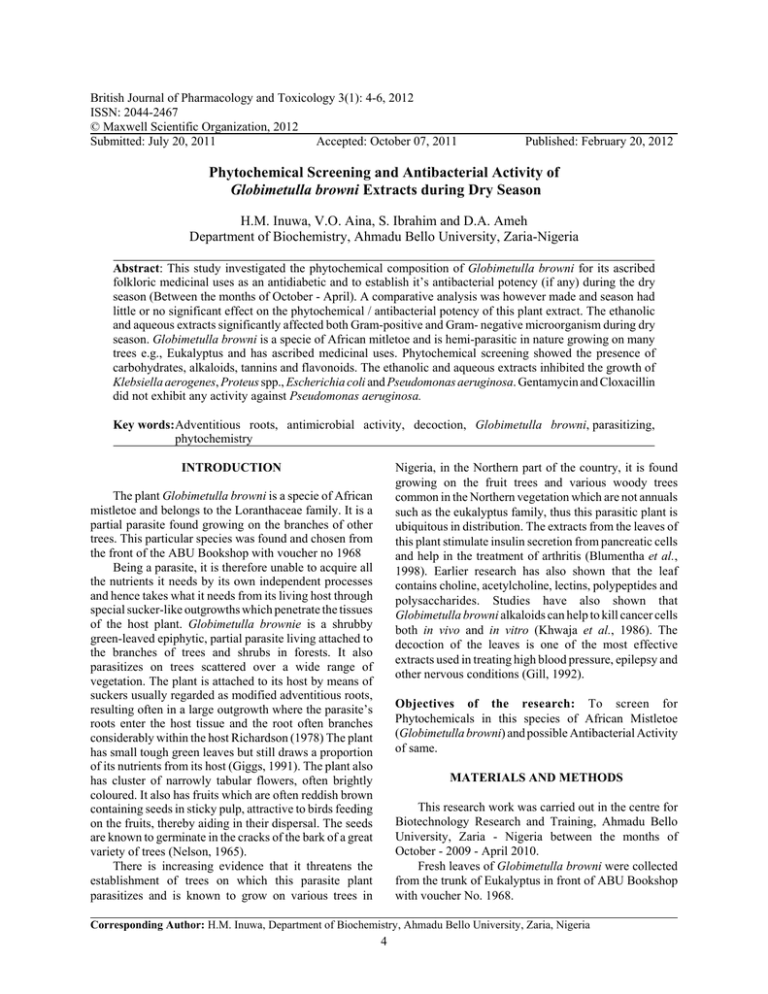
British Journal of Pharmacology and Toxicology 3(1): 4-6, 2012 ISSN: 2044-2467 © Maxwell Scientific Organization, 2012 Submitted: July 20, 2011 Accepted: October 07, 2011 Published: February 20, 2012 Phytochemical Screening and Antibacterial Activity of Globimetulla browni Extracts during Dry Season H.M. Inuwa, V.O. Aina, S. Ibrahim and D.A. Ameh Department of Biochemistry, Ahmadu Bello University, Zaria-Nigeria Abstract: This study investigated the phytochemical composition of Globimetulla browni for its ascribed folkloric medicinal uses as an antidiabetic and to establish it’s antibacterial potency (if any) during the dry season (Between the months of October - April). A comparative analysis was however made and season had little or no significant effect on the phytochemical / antibacterial potency of this plant extract. The ethanolic and aqueous extracts significantly affected both Gram-positive and Gram- negative microorganism during dry season. Globimetulla browni is a specie of African mitletoe and is hemi-parasitic in nature growing on many trees e.g., Eukalyptus and has ascribed medicinal uses. Phytochemical screening showed the presence of carbohydrates, alkaloids, tannins and flavonoids. The ethanolic and aqueous extracts inhibited the growth of Klebsiella aerogenes, Proteus spp., Escherichia coli and Pseudomonas aeruginosa. Gentamycin and Cloxacillin did not exhibit any activity against Pseudomonas aeruginosa. Key words:Adventitious roots, antimicrobial activity, decoction, Globimetulla browni, parasitizing, phytochemistry INTRODUCTION Nigeria, in the Northern part of the country, it is found growing on the fruit trees and various woody trees common in the Northern vegetation which are not annuals such as the eukalyptus family, thus this parasitic plant is ubiquitous in distribution. The extracts from the leaves of this plant stimulate insulin secretion from pancreatic cells and help in the treatment of arthritis (Blumentha et al., 1998). Earlier research has also shown that the leaf contains choline, acetylcholine, lectins, polypeptides and polysaccharides. Studies have also shown that Globimetulla browni alkaloids can help to kill cancer cells both in vivo and in vitro (Khwaja et al., 1986). The decoction of the leaves is one of the most effective extracts used in treating high blood pressure, epilepsy and other nervous conditions (Gill, 1992). The plant Globimetulla browni is a specie of African mistletoe and belongs to the Loranthaceae family. It is a partial parasite found growing on the branches of other trees. This particular species was found and chosen from the front of the ABU Bookshop with voucher no 1968 Being a parasite, it is therefore unable to acquire all the nutrients it needs by its own independent processes and hence takes what it needs from its living host through special sucker-like outgrowths which penetrate the tissues of the host plant. Globimetulla brownie is a shrubby green-leaved epiphytic, partial parasite living attached to the branches of trees and shrubs in forests. It also parasitizes on trees scattered over a wide range of vegetation. The plant is attached to its host by means of suckers usually regarded as modified adventitious roots, resulting often in a large outgrowth where the parasite’s roots enter the host tissue and the root often branches considerably within the host Richardson (1978) The plant has small tough green leaves but still draws a proportion of its nutrients from its host (Giggs, 1991). The plant also has cluster of narrowly tabular flowers, often brightly coloured. It also has fruits which are often reddish brown containing seeds in sticky pulp, attractive to birds feeding on the fruits, thereby aiding in their dispersal. The seeds are known to germinate in the cracks of the bark of a great variety of trees (Nelson, 1965). There is increasing evidence that it threatens the establishment of trees on which this parasite plant parasitizes and is known to grow on various trees in Objectives of the research: To screen for Phytochemicals in this species of African Mistletoe (Globimetulla browni) and possible Antibacterial Activity of same. MATERIALS AND METHODS This research work was carried out in the centre for Biotechnology Research and Training, Ahmadu Bello University, Zaria - Nigeria between the months of October - 2009 - April 2010. Fresh leaves of Globimetulla browni were collected from the trunk of Eukalyptus in front of ABU Bookshop with voucher No. 1968. Corresponding Author: H.M. Inuwa, Department of Biochemistry, Ahmadu Bello University, Zaria, Nigeria 4 Br. J. Pharmacol. Toxicol., 3(1): 4-6, 2012 Table 1: Phytochemical composition of the crude extracts of the leaves Globimetulla brownie Class of natural product ---------------------------------------------------------------------------------------------------------------------------------------------------------------------------------Plant specie Extract Lipids Carbohydrates Terpenoids Alkaloids Tannin Flavonoids Steroids Saponins Aqueous ++ ++ ++ ++ + Ethanolic ++ +++ +++ +++ + -: Absent; +: Weakly Present; + +: Present; +++: Strongly Present Table 2: Antimicrobial activity of Globimetulla brownie extracts dry season Zone of inhibition (mm)b Microorganisma ------------------------------------------------------------------------------------------------------------------------------------------------------------Extract Staphylococcus aureus Klebsiella aerogenes Proteus sp. Escherichia coli Pseudomonas aeruginosa Ethanol 10.00±0.95 11.00±0.91 11.00±0.85 9.00±3.6 9.00±0.57 Aqueous 9.00±0.95 12.00±0.91 13.00±0.85 10.00±3.6 9.00±0.57 Gentamycin 11.00±0.95 12.50±0.91 12.00±0.85 16.00±3.6 10.00±0.57 Cloxacillin 9.00±0.95 10.50±0.85 12.50±0.85 9.00±3.6 a: 100 :L of extract was applied to each well, Concentration of the extracts was 10 mg/mL; b: Values are the mean of three replicates + (SEM) Preparation of extracts: Fresh leaves were sun dried for about 2 weeks and macerated into a powder form. A 100 g quantity each was extracted separately using 500mL distilled water and 90% ethanol as solvents. The solvent extraction lasted 72 h at room temperature (25ºC). The crude extracts were concentrated to give 40 g of ethanolic and 65 g of aqueous extracts. Test microorganisms: Five bacteria species were employed as test microorganisms. These include: Staphylococus, Klebsiella, Proteus spp., Escherichia coli and Pseudomonas aeruginosa. These were sourced from the Microbiological unit of the Department of Applied Sciences, Kaduna Polytechnic, Kaduna and maintained on Muller Hinton slants at 4ºC before testing. Fig. 1: Globimetulla brownie parasitizing on eukalyptus in front of ABU bookshop 8 6 4 Ps e aer ud om ug i o na no s s a c he r col ichia i Es Pr spe oteus cie s 2 0 Sta p hy au lococ reu s cu s Phytochemical analysis: The extracts were subjected to analysis for the presence of saponins, steroids, alkaloids, flavonoids, tannins, carbohydrates, lipids and terpenoids using standard methods (Trease and Evans, 1978). Extract Ethanol Aqueous Gentamycin Colxacilin Kl aer ebsie oge lla n es Zone of inhibition (mm) Antibacterial screening/assay: Each test organism was cultured and incubated for 4 h. These were used to inoculate plates of muller hinton agar. The disks containing the different crude extracts were transferred using sterilized forceps to the agar plates. Sterile water and 95% ethanol were used as control. Standard antibiotic disks were used for comparison. The plates were incubated at 35ºC for 36 h before the examination for zones of inhibition of growth. Micro-organisms RESULTS AND DISCUSSION Fig. 2: Shows the histogram representation of the plant extract n = 5 on the various test microorganisms used during dry season The results of the phytochemical analysis on the crude leaf extracts are presented in Table 1. The results obtained indicated the presence of tannins, alkaloids, flavonoids, carbohydrates in both the aqueous and ethanolic extracts. Terpenoids, lipids and saponins were absent. The results of the antimicrobial activities are presented in Table 2. From the results in Table 2, none of the extracts inhibited Staphylococus aureus unlike the standard agents, gentamycin and cloxacillin. On the other hand, the extracts had pronounced activity against Pseudomonas aeruginosa which was resistant to both cloxacillin and gentamycin. 5 Br. J. Pharmacol. Toxicol., 3(1): 4-6, 2012 Generally, the results show that both the cold aqueous and ethanolic extracts had similar activities on the test organisms-Klebsiella aerogenes, Proteus spp, Escherichia coli and Pseudomonas aeruginosa, although the cold aqueous extract had a slightly higher inhibition zone than the ethanolic extract. Thus, the antibacterial activity of Globimetulla browni extracts observed in this study correlates well with its traditional use (PamplonaRoger, 1999), and compared favourably well with the activities of standard antibiotics used in this work namely gentamycin and cloxacillin. Figure 1 shows the parasitic plant (CIRCLED) parasitizing on its host (Eukalyptus) Fig. 2 depicts the broad spectrum effect on the microbial isolates with Escherichia coli, showing the widest zone of inhibition. research and Training , ABU Zaria for allowing the use of the reagents and facilities in the center. REFERENCES Blumentha, M., W.R. Busse and A. Goldberg, 1998. Therapeutic guide to Herbal medicine commission. E. Monogr., 171: 2-3. Gill, L.S., 1992. Tapinanthus dodoneifolius. Ethnomedical uses of Plants in Nigeria. University of Benin Press, Benin, pp: 244-245. Giggs, P., 1991. Mistletoe, myth, magic and medicine. Biochemist, 3: 3-4. Khwaja, T.A., C.B. Dias and S. Pentecost, 1986. Recent studies on the anticancer activities of some of mistletoe and alkaloid. Aucology, 3: 1-10. Nelson, M.S., 1965. Introduction to the flowering plants of West Africa. University of Press, London, pp: 28-31, 101-106. Pamplona-Roger, G.H., 1999. Medicinal plants; Encyclopedia of Medicinal plants. Safeliz Publication, Spain, pp: 245-247. Richardson, I.B.K., 1978. Lorantheceae (Mistletoe). In: Heywond, V.H., et al., (Eds.), Flowering Plants of the Word. Oxford University Press, Oxford, London, Melbourne, pp: 174-175. Trease, G.E. and W.C. Evans, 1978. Phamacognosy. 11th Edn., Bailliere Tindall Ltd. London, pp: 78. CONCLUSION Phytochemical Analysis indicated the presence of Alkaloids, carbohydrates, Tannins and Flavonoids. The ethanolic and aqueous extracts had broad spectrum action against both Gram-positive and Gram-negative microorganisms. Comparing data obtained during wet season, season didn’t seem to have any effect on the level of phytochemicals and the antibacterial activity. ACKNOWLEDGMENT The Coauthors wish to acknowledge the assistance of Professor A. J Nok, the Director centre for Biotechnolgy 6
